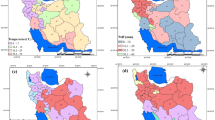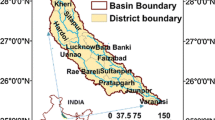Abstract
Because of the strong expected effects of climate change on water resources and food production it is important to use efficiently, as well as sustainable, water for agriculture production including both components rainfed “green water” and irrigated “blue water”. This is particularly important in the Cap Bon region northeastern Tunisia, where irrigation has increased in the past few decades, using intensively groundwater resources resulting in their degradation as well as their conflicting uses. Efficient management strategies that allow for compromises between agriculture production and water resource preservation are therefore needed. Such strategies require initial assessment of the sustainability of blue and green water resources management for crop production. For this purpose, the Global Water Footprint Standard approach has been used in the Cap Bon region. We calculated the volumetric blue and green water footprint related to wheat, tomato and citrus production as major crops in the region. The results show that the average of total WF of crop production was about 1821 Mm3/yr (85% green, 15% blue) over the period 1999–2008. The total WF (green + blue) of tomato and citrus crops averaged 131 m3/ton, 445 m3/ton, respectively. The green WF of wheat obtained in this study was about 1670 m3/ton, which is equal to the calculated world average (1620 m3/ton) by previous studies. This indicates that large opportunities for improving water footprint are found in low yielding farming systems, particularly in rainfed agriculture (water productivity is already higher in irrigated agriculture because of better yields). The assessment of sustainability of water use showed that the crop growth period when tomato and citrus need water is basically the same as the no precipitation period. The irrigation water requirement furthermore corresponds to the period where the water scarcity is high.
Access this chapter
Tax calculation will be finalised at checkout
Purchases are for personal use only
Similar content being viewed by others
References
IPCC (2013) Climate change 2013: the physical science basis. contribution of working group I to the fifth assessment report of the intergovernmental panel on climate change In: Stocker TF, Qin D, Plattner G-K, Tignor M, Allen SK, Boschung J, Nauels A, Xia Y, Bex V, Midgley PM (eds.) Cambridge University Press, Cambridge, 1535 p
Elloumi M (2016) La gouvernance des eauxsouterrainesen Tunisie, Report No. 6, IWMI Project Publication ‘Groundwater governance in the Arab World’, Cairo, Egypt
Falkenmark M (1995) Land-water linkages: a synopsis. In: Land and water integration and river basin management, vol 1. FAO Land and Water Bulletin, Rome, pp 15–16
Mekki I, Zitouna Chebbi R, Jacob F, Ben Mechlia N, Prévot L, Albergel J, Voltz M (2018) Impact of land use on soil water content in a hilly rainfed agrosystem. A case study in the Cap Bon Peninsula in Tunisia. AGROFOR Int J 3(1):64–75
Savenije HHG (2000) Water scarcity indicators: the deception of the numbers. Phys Chem Earth (B) 25:199–204
Mekonnen MM, Hoekstra AY (2010) A global and high-resolution assessment of the green, blue and grey water footprint of wheat. Hydrol Earth Syst Sci 14:1259–1276
Mekonnen MM, Hoekstra AY (2011) The green, blue and grey water footprint of crops and derived crop products. Hydrol Earth Syst Sci 15:1577–1600
Mekonnen MM, Hoekstra AY (2014) Water footprint benchmarks for crop production: a first global assessment. Ecol Ind 46:214–223
Chahed J, Besbes M, Hamdane A (2015) Virtual-water content of agricultural production and food trade balance of Tunisia. Int J Water Resour Dev 31:407–421
Hoekstra AY (2017) Water footprint assessment: evolvement of a new research field. Water Resour. Manag. 31:3061–3081
Latiri K, Lhomme JP, Annabi M, Setter TL (2010) Wheat production in Tunisia: progress, inter-annual variability and relation to rainfall. Eur J Agron 33:33–42
Zitouna Chebbi R, Mahjoub I, Mekki I, Ben Mechlia N (2017) Comparing evapotranspiration rates estimated from atmospheric flux, soil water balance and FAO 56 method of a small orange orchard in Tunisia. In: Marsal J, Girona J (eds) Proceedings of VIII international symposium on irrigation of horticultural crops. ActaHortic. ISHS 2017, vol 1150. https://doi.org/10.17660/ActaHortic.2017.1150.4
Mekki I, Bailly JS, Jacob F, Chebbi H, Ajmi T, Blanca Y, Zairi A, Biarnès A (2018) Impact of farmland fragmentation on rainfed crop allocation in Mediterranean landscapes: a case study of the Lebna watershed in Cap Bon, Tunisia. Land Use Policy 75:772–783
Mahjoub I, Zitouna Chebbi R, Mekki I, Ben Mechlia N (2017) Assessing irrigation scheduling by FAO method using soil-plant-atmosphere water stress indictors on four orange varieties (Citrus sinensis (L.) Osbeck). In: Marsal J, Girona J (eds) Proceedings of VIII international symposium on irrigation of horticultural crops. ActaHortic. ISHS 2017, vol 1150. https://doi.org/10.17660/ActaHortic.2017.1150.20
Mekki I, Ghazouani W, Closas A, Molle F (2017) Perceptions of groundwater degradation and mitigation responses in the Haouaria region in Tunisia. Groundwater Sustain Dev 5:101–110
Frija I, Frija A, Chebil A, CheikhM’Hamed H, Speelman S, Makhlouf M (2014) Marginal water productivity of irrigated durum wheat in semi-arid Tunisia. J Agric Sci 6:84–95
Acterra, Gret et Suez Consulting group (2020) Analyse des effets des scénariosde changement climatique RCP 4.5et RCP 8.5. Tunisie-Contribution aux éléments de laphase préparatoiredu processus du Plan Nationald’ Adaptation (Axe 2), 169 p
Ben Zekri Y, Barkaoui K, Marrou M, Mekki I, Belhouchette H, Wery J (2018) On farm analysis of the effect of the preceding crop on N uptake and grain yield of Durum wheat in Mediterranean conditions. Arch Agron Soil Sci. https://doi.org/10.1080/03650340.2018.1514111
Souissi I, Boisson JM, Mekki I, Theronds O, Flichman G, Wery J, Belhouchette H (2017) Assessing the resilience of farming systems to climate change in the South Mediterranean area: a Tunisian case study. Regional Environ Change. https://doi.org/10.1007/s10113-017-1130-8
Hoekstra AY, Chapagain AK, Aldaya MM, Mekonnen MM (2011) The water footprint assessment manual: setting the global standard. Earthscan, London
Aldaya MM, Allan JA, Hoekstra AY (2010) The strategic importance of green water in international crop trade. Ecol Econ 2010(69):887–894
Ewaid SH, Ali Abed S, Al-Ansari N (2019) Water footprint of wheat in Iraq. Water 11:535. https://doi.org/10.3390/w11030535
Chouchane H, Hoekstra AY, Krol MS, Mekonnen MM (2015) Water footprint of Tunisia from an economic perspective. Ecol Ind 52:311–319
Luan XB, Yin YL, Wu PT, Sun SK, Wang YB, Gao XR, Liu J (2018) An improved method for calculating the regional crop water footprint based on a hydrological process analysis. Hydrol Earth Syst Sci 22:5111–5123. https://doi.org/10.5194/hess-22-5111-2018
Yuguda TK, Li Y, Zhang W, Ye Q (2020) Incorporating water loss from water storage and conveyance into blue water footprint of irrigated sugarcane: a case study of Savannah Sugar Irrigation District, Nigeria. Sci Total Environ 715:1368–1386. https://doi.org/10.1016/j.scitotenv.2020.136886
Hoekstra AY, Chapagain AK, Aldaya MM, Mekonnen MM (2011) The Water Footprint Assessment Manual: Setting the Global Standard. Earthscan, London
Aldaya MM, Allan JA, Hoekstra AY (2010) The strategic importance of green water in international crop trade. Ecol Econ 69:887–894
CRDA-Nabeul (2018) Annual Report of 2018 Activities. Technical report Regional planning Commission for Agricultural Development, Nabeul Tunisia (in French)
Molden D (2007) Water for Food, Water for Life: A Comprehensive Assessment of Water Management in Agriculture. Earthscan/International Water Management Institute, London/Colombo
Mueller N, Gerber J, Johnston M et al (2012) Closing yield gaps through nutrient and water management. Nature 490:254–257
Reidsma P, Ewert F, Lansink AO, Leemans R (2010) Adaptation to climate change and climate variability in European agriculture: the importance of farm level responses. Eur J Agron 32(1):91–102
Rodriguez D, deVoil P, Power B, Cox H, Crimp S, Meinke H (2011) The intrinsic plasticity of farm businesses and their resilience to change. An Australian example. Field Crops Res 124:157–170. https://doi.org/10.1016/j.fcr.2011.02.012
Author information
Authors and Affiliations
Editor information
Editors and Affiliations
Rights and permissions
Copyright information
© 2021 Springer Nature Switzerland AG
About this chapter
Cite this chapter
Mekki, I., Zitouna-Chebbi, R. (2021). Assessing the Blue and Green Water Resources Use for Regional Crop Production in a Semi Arid Area (The Cap Bon Case Study, Tunisia). In: Khebour Allouche, F., Abu-hashim, M., Negm, A.M. (eds) Agriculture Productivity in Tunisia Under Stressed Environment. Springer Water. Springer, Cham. https://doi.org/10.1007/978-3-030-74660-5_12
Download citation
DOI: https://doi.org/10.1007/978-3-030-74660-5_12
Published:
Publisher Name: Springer, Cham
Print ISBN: 978-3-030-74659-9
Online ISBN: 978-3-030-74660-5
eBook Packages: Earth and Environmental ScienceEarth and Environmental Science (R0)




